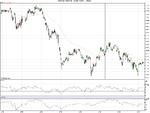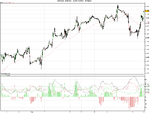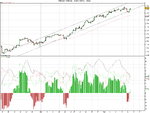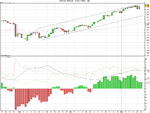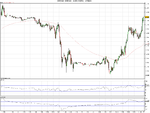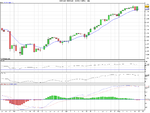lurkerlurker
Senior member
- Messages
- 2,482
- Likes
- 150
Hi all
I am very new to trading, and newer to these boards. I have posted frequently over in the Dow 2007 thread, but as my trading development keeps coming up over there, I don't wish to take this thread off topic. I have found that the questions and feedback I receive from T2W members creates an expectation of accountability, and has allowed me to become a more sober trader, avoiding some bad trades.
The idea of this thread is to note my trades, and my observations about my own trading behaviour. I would hope that other members here would be so kind as to share feedback, observations, suggestions, advice, and comments where appropriate.
I am trading a small account via spreadbetting. I am aware of the differences of opinion regarding the efficacy of spreadbetting, however for the moment the tax advantages and small stake sizes make it worthwhile. Should I ever go fully "professional", I would look into trading the actual futures, with all the attendant advantages. I have an IT background, but am currently between jobs and looking to trade full time. I am not setting myself unrealistic targets, like making enough money trading to support myself, because I believe that creates additional pressure while trading. I would like to make enough to justify time spent in front of the quote screen, but otherwise I recognise this is a learning experience, and I really have no right to expect anything better than breakeven at this stage.
What I would like to do here is to post all live trades, and my reasoning for entering and exiting them, along with an end of day review. I would imagine that this will attract some small amount of commentary from those who are wiser, and this is a large motivation for keeping a public journal. I do not expect to find many people who have the time to assist me with learning what I should be able to learn independently, and I am not looking for handholding, holy grails, or anything else sometimes associated with lazyness on the part of new traders. Some feedback and guidance where possible would be nice.
To start off, since I won't be trading again until Wednesday 16th, I am going to list what I believe are the main issues with my trading, and then I intend to follow up with short term goals to improve this.
I will be trading index futures, mostly the Dow and FTSE. I am avoiding ForEx for the time being, and will only enter equities if I see a good setup. I intend to day trade without overnight positions at the moment, although in the future I would look to EOD / swing trading to catch bigger parts of moves.
Feedback appreciated.
Thanks for reading.
~LL
I am very new to trading, and newer to these boards. I have posted frequently over in the Dow 2007 thread, but as my trading development keeps coming up over there, I don't wish to take this thread off topic. I have found that the questions and feedback I receive from T2W members creates an expectation of accountability, and has allowed me to become a more sober trader, avoiding some bad trades.
The idea of this thread is to note my trades, and my observations about my own trading behaviour. I would hope that other members here would be so kind as to share feedback, observations, suggestions, advice, and comments where appropriate.
I am trading a small account via spreadbetting. I am aware of the differences of opinion regarding the efficacy of spreadbetting, however for the moment the tax advantages and small stake sizes make it worthwhile. Should I ever go fully "professional", I would look into trading the actual futures, with all the attendant advantages. I have an IT background, but am currently between jobs and looking to trade full time. I am not setting myself unrealistic targets, like making enough money trading to support myself, because I believe that creates additional pressure while trading. I would like to make enough to justify time spent in front of the quote screen, but otherwise I recognise this is a learning experience, and I really have no right to expect anything better than breakeven at this stage.
What I would like to do here is to post all live trades, and my reasoning for entering and exiting them, along with an end of day review. I would imagine that this will attract some small amount of commentary from those who are wiser, and this is a large motivation for keeping a public journal. I do not expect to find many people who have the time to assist me with learning what I should be able to learn independently, and I am not looking for handholding, holy grails, or anything else sometimes associated with lazyness on the part of new traders. Some feedback and guidance where possible would be nice.
To start off, since I won't be trading again until Wednesday 16th, I am going to list what I believe are the main issues with my trading, and then I intend to follow up with short term goals to improve this.
Trading Issues
- Poor money management
- Trading against the trend
- Over reliance on discretion for entries and exits
- Failure to confirm trends and setups on longer timeframes
- Poor use of stop loss orders (too close, or too far away) - placing them for the wrong reasons
- Overtrading
Short Term Goals
- Identify the trend, and trade with the trend
- Confirm setups with multiple timeframes (5min, 30min, and daily for intra-day trading)
- Keep a full record (on T2W and handwritten) or trades taken, pips won/lost, reasons for entering and exiting, and thoughts
- Keep small stakes for the time being, until consistent profits can be achieved
- Avoidance of "gamble entries" and high risk trades
I will be trading index futures, mostly the Dow and FTSE. I am avoiding ForEx for the time being, and will only enter equities if I see a good setup. I intend to day trade without overnight positions at the moment, although in the future I would look to EOD / swing trading to catch bigger parts of moves.
Feedback appreciated.
Thanks for reading.
~LL

